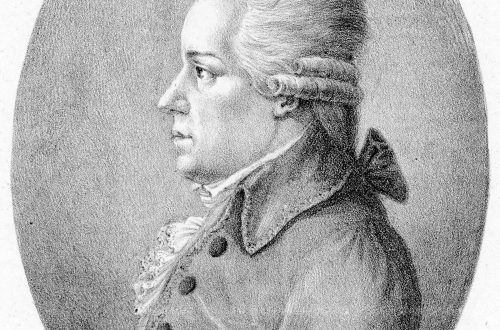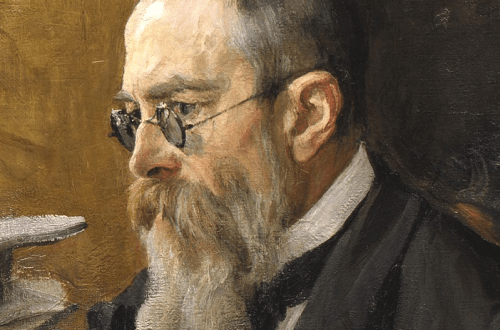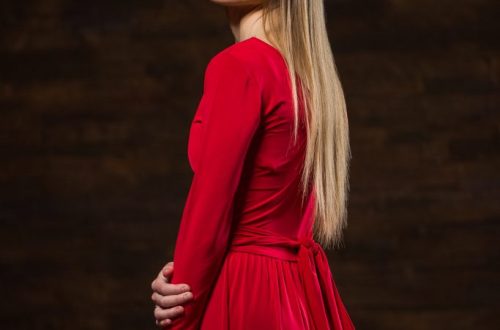
Edison Vasilyevich Denisov |
Edison Denisov

The imperishable beauty of great works of art lives in its own time dimension, becoming the highest reality. E. Denisov
Russian music of our day is represented by a number of major figures. Among the first of them is Muscovite E. Denisov. Having studied piano playing (Tomsk Music College, 1950) and university education (Physics and Mathematics Faculty of Tomsk University, 1951), the twenty-two-year-old composer entered the Moscow Conservatory to V. Shebalin. The years of searching after graduating from the conservatory (1956) and graduate school (1959) were marked by the influence of D. Shostakovich, who supported the talent of the young composer and with whom Denisov became friends at that time. Realizing that the conservatory taught him how to write, and not how to write, the young composer began to master modern methods of composition and search for his own path. Denisov studied I. Stravinsky, B. Bartok (the Second String Quartet – 1961 is dedicated to his memory), P. Hindemith (“and put an end to him”), C. Debussy, A. Schoenberg, A. Webern.
Denisov’s own style takes shape gradually in the compositions of the early 60s. The first bright take-off of the new style was “The Sun of the Incas” for soprano and 11 instruments (1964, text by G. Mistral): the poetry of nature, with echoes of the most ancient animist images, appears in an outfit of sonorous iridescent intense musical colors. Another facet of the style is in Three Pieces for cello and piano (1967): in the extreme parts it is music of deep lyrical concentration, a tense cello cantilena with the most delicate sounds of the piano in a high register, in contrast with the greatest rhythmic energy of asymmetrical “points, pricks, slaps”, even the “shots” of an average play. The Second Piano Trio (1971) also adjoins here – music of the heart, subtle, poetic, conceptually significant.
Denisov’s style is versatile. But he rejects a lot of current, fashionable in modern music – imitation of someone else’s style, neo-primitivism, aestheticization of banality, conformist omnivorousness. The composer says: “Beauty is one of the most important concepts in art.” In our time, many composers have a tangible desire to search for new beauty. In 5 pieces for flute, two pianos and percussion, Silhouettes (1969), portraits of famous female images emerge from the motley fabric of sound – Donna Anna (from W. A. Mozart’s Don Juan), Glinka’s Lyudmila, Lisa (from The Queen of Spades) P. Tchaikovsky), Lorelei (from a song by F. Liszt), Maria (from A. Berg’s Wozzeck). Birdsong for prepared piano and tape (1969) brings the aroma of the Russian forest, bird voices, chirps and other sounds of nature into the concert hall, the source of pure and free life. “I agree with Debussy that seeing the sunrise can give a composer much more than listening to Beethoven’s Pastoral Symphony.” In the play “DSCH” (1969), written in honor of Shostakovich (the title is his initials), a letter theme is used (Josquin Despres, J. S. Bach, Shostakovich himself composed music on such themes). In other works, Denisov widely uses the chromatic intonation EDS, which sounds twice in his name and surname: EDiSon DEniSov. Denisov was greatly influenced by direct contact with Russian folklore. About the cycle “Lamentations” for soprano, percussion and piano (1966), the composer says: “There is not a single folk melody here, but the entire vocal line (in general, even instrumental) is connected in the most direct way with Russian folklore without any moments of stylization and without any citations”.
A fantastic combination of the exquisite beauty of refined sounds and absurdist text is the main tone of the ten-movement cycle “Blue Notebook” (on the lines of A. Vvedensky and D. Kharms, 1984) for soprano, reader, violin, cello, two pianos and three groups of bells. Through the incredible grotesque and biting alogism (“God languished in a cage there without eyes, without arms, without legs …” – No. 3), tragic motives suddenly break through (“I see a distorted world, I hear the whisper of muffled lyres” – No. 10).
Since the 70s. increasingly Denisov turns to large forms. These are instrumental concertos (St. 10), a wonderful Requiem (1980), but it is rather a lofty philosophical poem about human life. The best achievements include the Violin Concerto (1977), the lyrically penetrating Cello Concerto (1972), the most original Concerto piccolo (1977) for a saxophonist (playing different saxophones) and a huge percussion orchestra (6 groups), the ballet “Confession” by A. Musset (post . 1984), the opera “Foam of Days” (based on the novel by B. Vian, 1981), performed with great success in Paris in March 1986, “Four Girls” (based on P. Picasso, 1987). A generalization of the mature style was the Symphony for large orchestra (1987). The words of the composer could become an epigraph to it: “in my music, lyricism is the most important thing.” The breadth of symphonic breathing is achieved by a diverse range of lyrical sonorities – from the most gentle breaths to mighty waves of expressive pressures. In connection with the 1000th anniversary of the baptism of Russia, Denisov created a large work for the choir a cappella “Quiet Light” (1988).
Denisov’s art is spiritually related to the “Petrine” line of Russian culture, the tradition of A. Pushkin, I. Turgenev, L. Tolstoy. Striving for high beauty, it opposes the tendencies of simplification that are frequent in our time, the all-too-vulgar easy accessibility of pop thinking.
Y. Kholopov




